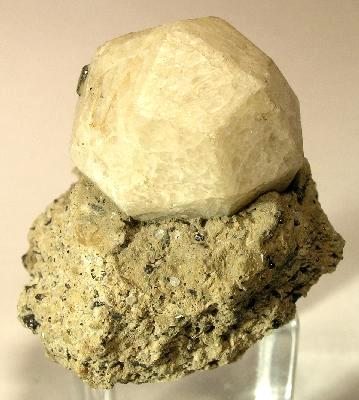The Mineral leucite

Leucite is a member of the feldspathoid group, forming directly from cooling lava in volcanic rock. It forms in low-silica environments where little Quartz is present. When Leucite forms at high temperatures, it crystallizes as
isometric crystals in trapezohedral crystal form. As it cools,
its crystal structure becomes unstable, and transforms into
tetragonal form while retaining the original isometric shape. Though Leucite crystals are usually equant, the crystal faces may be slightly uneven due to the alteration. When in the oxidized zone, Leucite often alters to Pseudoleucite, which is a chalky-white combination of Orthoclase, Nepheline, and Analcime. Extensive oxidation may further break it down into Kaolinite or clay.
Chemical Formula
KAlSi2O6
Color
White to gray, sometimes with a yellow or brown tinge. Rarely colorless.
Crystal System
Tetragonal
Crystal Habits
Crystals are pseudo-isometric, forming as trapezohedrons. May be in single individual crystals, groups of crystals, or in grainy masses. Single crystals may be very well-formed, and may be floater crystals when smoothly popping out of a matrix. Crystals may also be intergrown.
Uses
Leucite is an rare and somewhat odd collectors mineral. Good crystals, especially those from the Italian localities, are in demand by collectors. Leucite was once used as a fertilizer for its potassium content.
Noteworthy Localities
The best occurrences for Leucite are in Italy. Several Italian deposits have produced fairly large and often individual crystals. Important localities include Roccamonfina, in Campania; Monte Somma, at Vesuvius; and Ariccia, in the Alban Hills near Rome. Colorless micro-crystals are found in Eifel Mountains, Germany, at Üdersdorf and Ettrigen; and large single crystals from Cascata, Poços de Caldas, São Paulo, Brazil.
In the U.S., dark single and large crystals were once found in Magnet Cove, Garland Co., Arkansas; and small crystals from the Leucite Hills District, Sweetwater Co., Wyoming.
Common Mineral Associations
Olivine, Nepheline, Augite, Biotite
Distingushing Similar Minerals
Analcime - Usually has more reflective luster and is more often associated with zeolites; otherwise can be extremely difficult to distinguish.
Garnet - Harder, usually a different color.